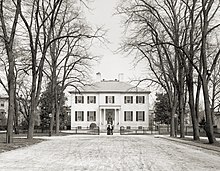Governor of Virginia
The Governor of Virginia ( Governor of Virginia ) is the head of government of the US state of Virginia . The incumbent has been Democrat Ralph Northam since January 2018 .
choice
The governor is directly elected by the people for four years. Citizens of the United States who have lived in Virginia for at least five years and are at least 30 years old are eligible . The respective office holder is not eligible for election. Virginia is (as of 2014) the only state in which a direct re-election of the governor is excluded.
Rights and obligations
- The governor must be a resident of the Virginia government office.
- In every ordinary session he must report to the State Parliament , the Virginia General Assembly , in the form of the State of the State Address . He can convene Parliament for extraordinary sessions and must do so if a two-thirds majority of the two Houses of Parliament so request.
- The governor is responsible for the implementation of the law.
- The governor receives an annual salary of US $ 135,000.
- The governor has the right to make recommendations to parliament regarding legislation.
- The governor has a right of veto . All legislative decisions must be presented to the governor before they become law. The governor can sign the law or leave it unsigned for seven days until it becomes law or appeal. The veto becomes ineffective if the parliament decides to do so with a two-thirds majority in both houses.
- The governor also has the right to a veto linked to recommendations and change requests ( line item veto ). In this case, parliament must either accept the amendments with a majority in both houses or reject the veto with a two-thirds majority in both houses.
- The governor, as commander in chief of the Virginia National Guard, is responsible for the security of the state.
- The governor represents Virginia vis-à-vis other states and foreign powers.
- The governor can make appointments to vacant posts until Parliament fills the posts.
- The governor can mitigate fines or punishments or issue pardons . The governor may also restore the right to vote or remove other civil rights penalties.
history
The office of governor of Virginia dates back to the first permanent English settlement in America, Jamestown . The Virginia Company of London set up a London- based council to exercise government , the president of which served as governor. Thomas Smith was nominally the first president of the council, but never left England. Edward Maria Wingfield was the first resident president of the council, the first to actually exercise governance over Virginia. The Virginia Company abolished the council on May 23, 1609, replacing it with a governor, John Smith .
The English monarchy took over colony Virginia from the Virginia Company in 1624 and made the country a crown colony . Most of the governors appointed by the crown resided in England, so that his local deputy ( Deputy Governor or Lieutenant Governor ) actually exercised power. During the reign of Oliver Cromwell , the governor was appointed by the English Republic.
Virginia gained independence during the American Revolution , with Patrick Henry as its first governor. The governor was elected by the state parliament until 1851 and since then directly by the people. During the Civil War , Francis Harrison Pierpont was governor of the Union-controlled parts of the state. Pierpont also served as the federal-appointed provisional governor during the Reconstruction phase .
After regaining the right to self-government in 1874, Virginia elected James Lawson Kemper as governor. The first Republican governor since Reconstruction was A. Linwood Holton from 1969 .
Douglas Wilder was elected first and (after P. B. S. Pinchback second overall) African American governor of a state in 1990 .
Since 1851, unlike in other states, Virginia gubernatorial elections have been held in years when there are no national elections (President, Senate, House of Representatives), namely one year after the presidential elections (2001, 2005, 2009, etc.). This fact and the exclusion of immediate re-election are cited as reasons for the low turnout .
Tim Kaine , Governor from 2006 to 2010, was inducted into office on January 14, 2006. Because of the renovation of the Virginia State Capitol in Richmond , the inauguration took place for the first time since the inauguration of Thomas Jefferson in Williamsburg in 1779 .
Salutation
Unlike most other states' governors, the governor of Virginia is formally addressed as His Excellency rather than The Honorable .
See also
Web links
Footnotes
- ↑ www.apva.org: A Timeline of Events and References ( Memento of the original from November 22, 2005 in the Internet Archive ) Info: The archive link was automatically inserted and not yet checked. Please check the original and archive link according to the instructions and then remove this notice.



